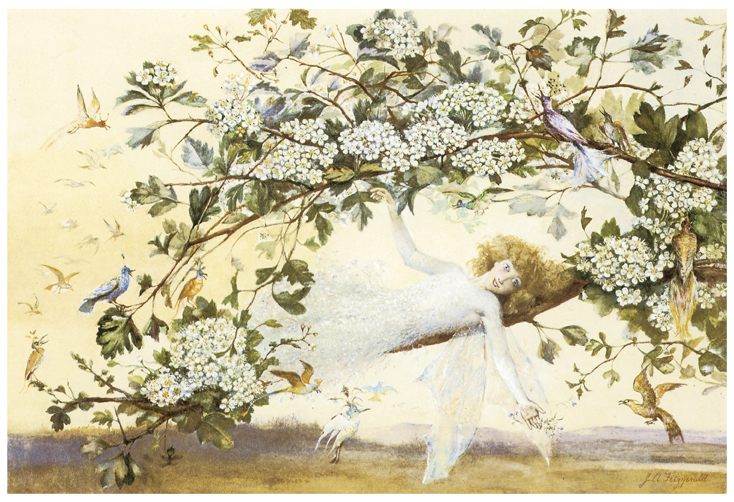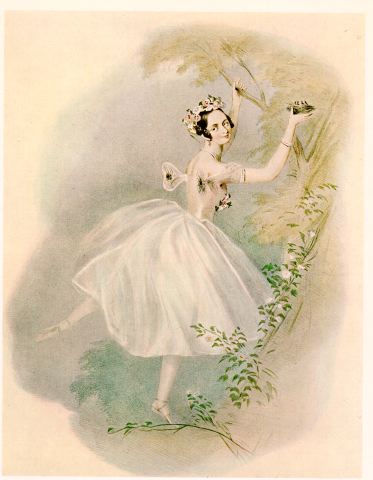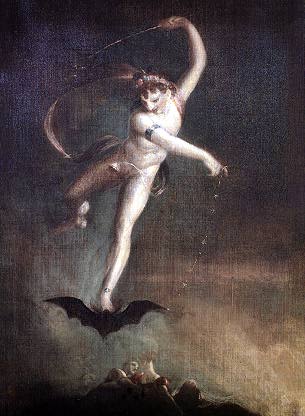Winged spirit of Germanic and Celtic mythology, sometimes considered an angel, the Sylph (Sylphid) lives in the woods and dances in the wind. It is depicted as a long-legged girl with a diaphanous skin and long blonde hair (sometimes honey-colored, sometimes silver), a delicate and budding beauty that emanates the charm of grace.
The alchemist Paracelsus describes the sylphids in his book “De Nymphis, Sylphis, Pygmaeis et Salamandris et coeteris spiritibus” cataloging them among the elemental spirits.
The most famous name is Ariel immortalized by Shakespeare in his comedy “The Tempest”.
Ariel is the sylph of the Air, its power is that of the wind and its character is the same, changeable and capricious: caressing and playful or threatening like a storm.
So Ariel sleeps in the corolla of a primrose, rides a bat and, sitting on a cloud, contemplates the human leisures.
The song of Ariel is melodious and fairy, seductive to the point of inducing madness.
Sylphs control winds and rain and give shape to clouds, lightning is their weapon and their power is stronger during sunrise or twilight.
Sylphs creatures of Spring

John Anster Fitzgerald depicts a winged, ephebic, and feminine sylph as he sways on the branch of a blossoming hawthorn surrounded by multicolored birds: the sylphs are the creatures of Spring, and their songs and dances awaken Nature.
Their language is similar to that of birds, so they communicate with music and their favorite instrument is the flute.

To the sylphs the ancients gave the labor of modeling the snowflakes and gathering clouds. This latter they accomplished with the cooperation of the undines who supplied the moisture. The winds were their particular vehicle and the ancients referred to them as the spirits of the air. They are the highest of all the elementals, their native element being the highest in vibratory rate. They live hundreds of years, often attaining to a thousand years and never seeming to grow old. The leader of the sylphs is called Paralda, who is said to dwell on the highest mountain of the earth. The female sylphs were called sylphids.
The sylphs sometimes assume human form, but apparently for only short periods of time. Their size varies, but in the majority of cases they are no larger than human beings and often considerably smaller. It is said that the sylphs have accepted human beings into their communities and have permitted them to live there for a considerable period; in fact, Paracelsus wrote of such an incident, but of course it could not have occurred while the human stranger was in his physical body. By some, the Muses of the Greeks are believed to have been sylphs, for these spirits are said to gather around the mind of the dreamer, the poet, and the artist, and inspire him with their intimate knowledge of the beauties and workings of Nature. To the sylphs were given the eastern corner of creation. Their temperament is mirthful, changeable, and eccentric. The peculiar qualities common to men of genius are supposedly the result of the cooperation of sylphs, whose aid also brings with it the sylphic inconsistency. The sylphs labor with the gases of the human body and indirectly with the nervous system, where their inconstancy is again apparent. They have no fixed domicile, but wander about from place to place–elemental nomads, invisible but ever-present powers in the intelligent activity of the universe..” Mainly P. Hall “The Secret Teachings Of All Ages (from here)”
AIR DU SYLPHE
Air Du Sylphe the melody in the central part takes the shape of a medieval estampie.
DANZE EN POINTE

The classical ballet could have been born from the inspiration of a sylphid, such is the title of the first romantic ballet born from the choreography of Filippo Taglioni for his daughter Maria who excelled in dance en pointe (the first performance was held in Paris in March 1832) .
Celtic legends were fashionable (James Macpherson with the Ossian saga published in 1807 as a translation of ancient Gaelic songs in the Highlands, gave rise to Romanticism) and the story takes place in Scotland, in the Highlands to tell the impossible love between a human and a fairy creature: James about to marry with Effie falls in love with a beautiful sylphid that seduces him in a dream.

